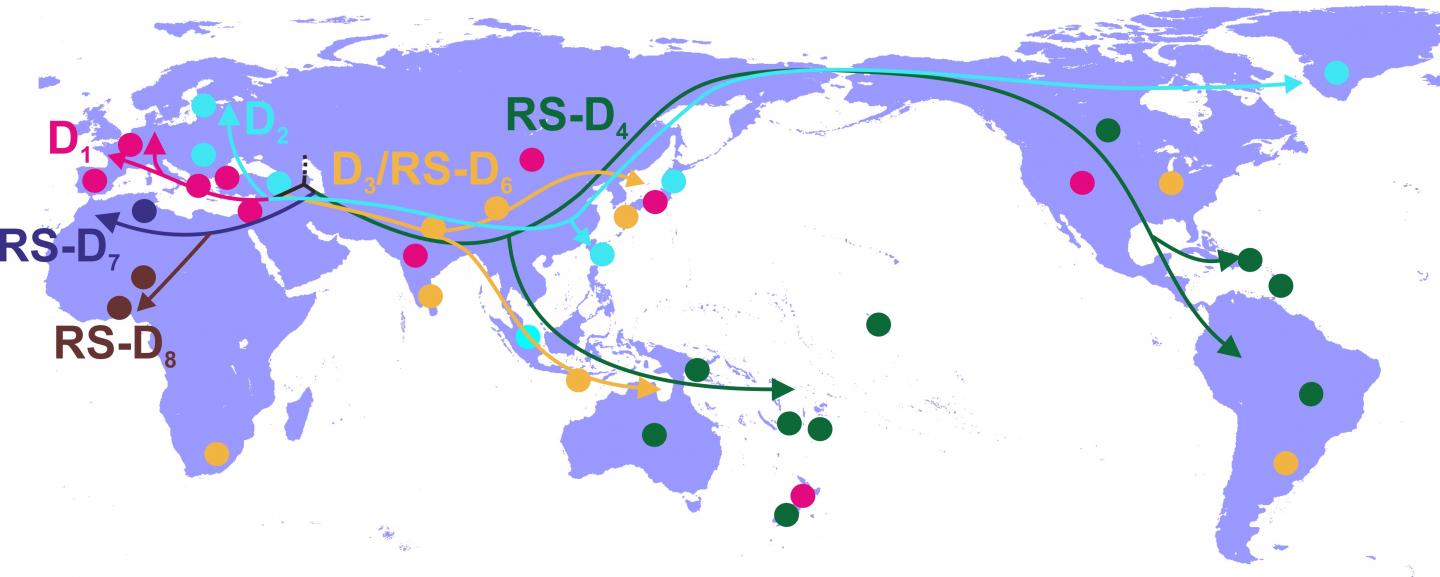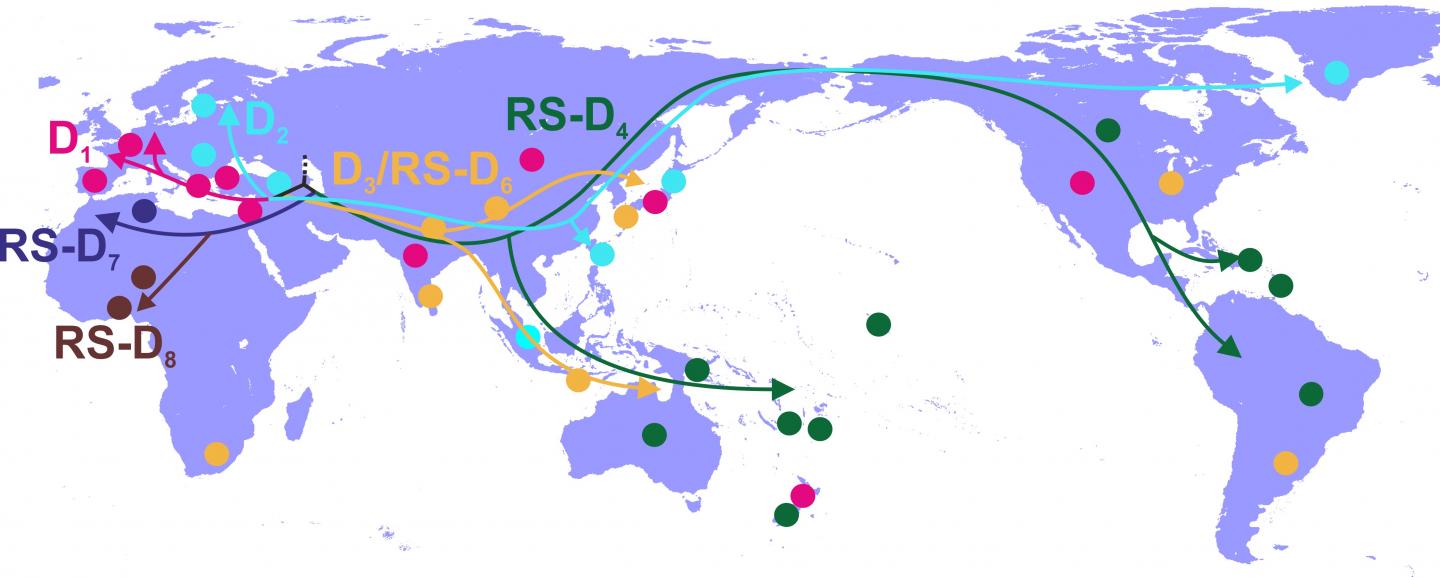
Credit: Kostaki et al., 2018
Researchers have provided new insight on the geographical origins and global spread of two classes of the hepatitis B virus (HBV), according to a study in eLife.
The findings identify the HBV genotypes D and A (HBV-D and HBV-A) as having originated in the Middle East and North Africa. They also reveal considerable differences in the global dissemination patterns of these genotypes, adding to our understanding of both the historic and prehistoric spread of one of the world's largest viral pandemics.
HBV, the main cause of liver disease, is a global public health concern with an estimated 257 million people living with the infection, according to figures from the World Health Organization*. The virus is classified into nine genotypes (A-I). HBV-A and HBV-D are present around the globe, with A prevailing in Europe and Africa and D in Europe and the Middle East.
"The epidemiological history of HBV-D and HBV-A remains unclear due to a lack of relevant studies," says lead author Evangelia-Georgia Kostaki, PhD Candidate in Molecular Epidemiology at the National and Kapodistrian University of Athens, Greece. "In order to uncover more of this detail, we wanted to establish how HBV was disseminated across different geographic regions."
To do this, the team used 916 HBV-D and 493 HBV-A full-genome sequences to reconstruct these genotypes' global evolutionary development and diversification, known as their phylogeny, and analyse their levels of regional clustering. They revealed that HBV-D's geographical origin was in North Africa and the Middle East, although they were unable to infer the exact origin accurately from the available data. Their analysis also suggests the origin of HBV-A is close to Africa and Europe, and likely in the Middle East and Central Asia.
"Major dispersal pathways for HBV-D were complex, including different geographic regions," explains senior author Dimitrios Paraskevis, Assistant Professor of Epidemiology and Preventive Medicine at the National and Kapodistrian University of Athens. "We found low levels of HBV-D transmission occurred locally in North Africa and the Middle East, suggesting a high amount of movement among populations infected with HBV in these areas. This is in line with our previous observations about the central role of these regions as hubs for human expansion, due to the early development of agriculture and the resulting spread and genetic shuffling of HBV-D."**
Paraskevis adds that after HBV-A's initial spread in Central Africa, this genotype followed two distinct pathways: one to eastern and southern Africa, and another to sub-Saharan and western Africa. Spillovers later led to major regional transmissions towards Brazil, Haiti and the Indian subcontinent, most likely as a result of the slave trade.
Together, these results highlight considerable differences in the global dissemination patterns of HBV-D and HBV-A, as well as different levels of their regional clustering, which likely reflect the impact of prehistoric and more recent human migrations and other activities on the evolution of these HBV genotypes.
###
References
The paper 'Unravelling the history of hepatitis B virus genotypes A and D infection using a full-genome phylogenetic and phylogeographic approach' can be freely accessed online at https://doi.org/10.7554/eLife.36709. Contents, including text, figures and data, are free to reuse under a CC BY 4.0 license.
Along with Evangelia-Georgia Kostaki and Dimitrios Paraskevis, this research was carried out by Timokratis Karamitros, Garyfallia Stefanou, Konstantinos Angelis and Angelos Hatzakis at the National and Kapodistrian University of Athens, in collaboration with Ioannis Mamais from the European University of Cyprus and Anna Kramvis from the University of the Witwatersrand, Johannesburg, South Africa.
*http://www.who.int/news-room/fact-sheets/detail/hepatitis-b
**Dating the origin and dispersal of hepatitis B virus infection in humans and primates
Media contact
Emily Packer, Senior Press Officer
eLife
[email protected]
01223 855373
About eLife
eLife aims to help scientists accelerate discovery by operating a platform for research communication that encourages and recognises the most responsible behaviours in science. We publish important research in all areas of the life and biomedical sciences, including Microbiology and Infectious Disease, which is selected and evaluated by working scientists and made freely available online without delay. eLife also invests in innovation through open source tool development to accelerate research communication and discovery. Our work is guided by the communities we serve. eLife is supported by the Howard Hughes Medical Institute, the Max Planck Society, the Wellcome Trust and the Knut and Alice Wallenberg Foundation. Learn more at https://elifesciences.org.
To view the latest Microbiology and Infectious Disease research published in eLife, visit https://elifesciences.org/subjects/microbiology-infectious-disease.
Media Contact
Emily Packer
[email protected]
@elife
http://www.elifesciences.org
Original Source
https://elifesciences.org/for-the-press/2bc7c0e1/scientists-shed-new-light-on-hepatitis-b-virus-origins http://dx.doi.org/10.7554/eLife.36709





